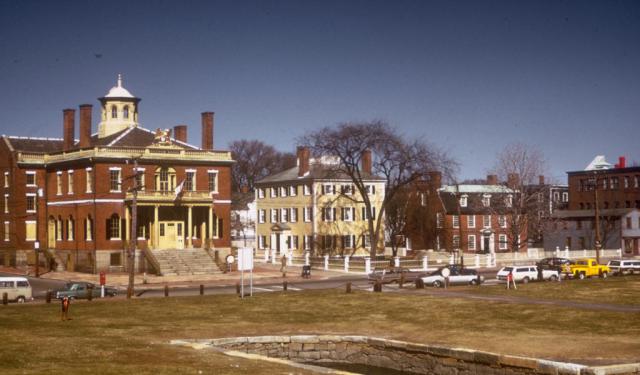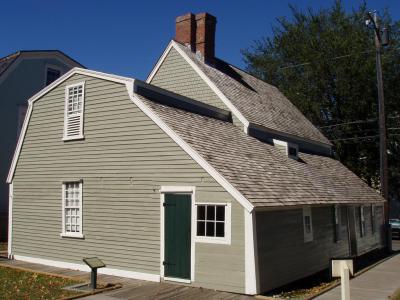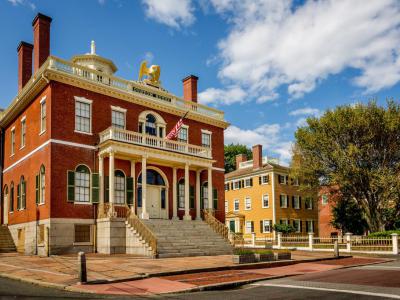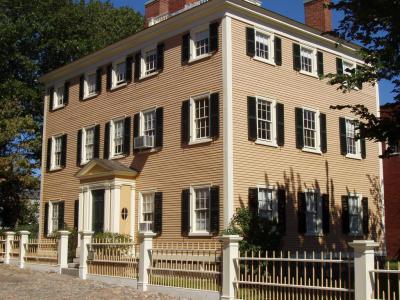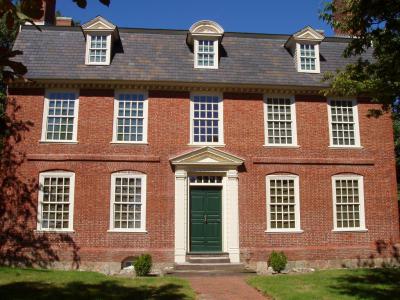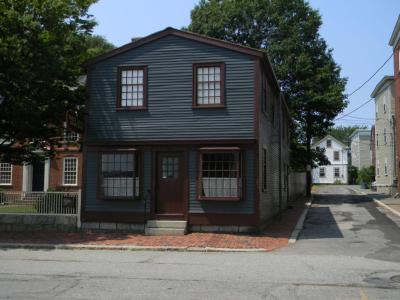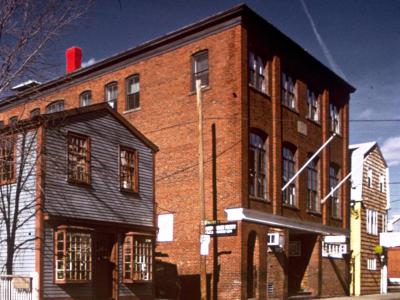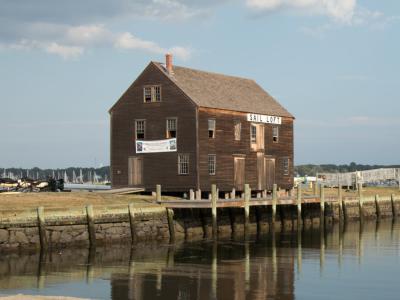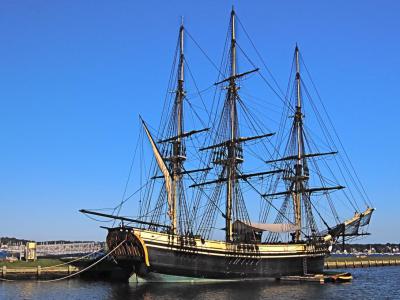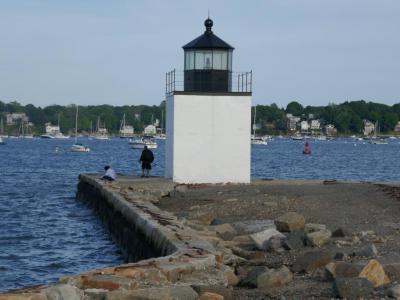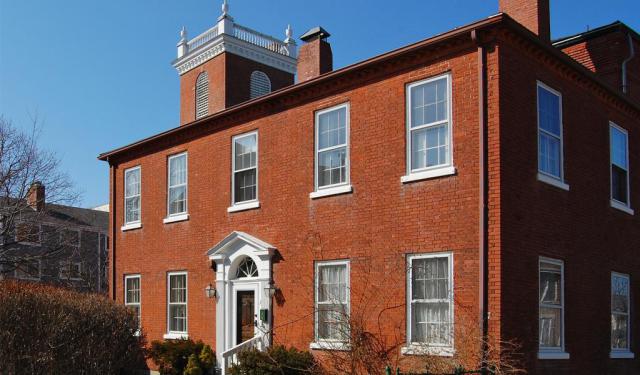Salem Maritime National Historic Site Tour (Self Guided), Salem
The Salem Maritime National Historic Site is a National Historic Site consisting of 12 historic structures, one replica tall-ship, and about 9 acres (36,000 m2) of land along the waterfront of Salem Harbor in Salem, Massachusetts, United States. Salem Maritime is the first National Historic Site established in the United States (March 17, 1938).[1] It interprets the Triangle Trade during the colonial period, in cotton, rum, sugar and slaves; the actions of privateers during the American Revolution; and global maritime trade with the Far East, after independence. ***PH***
How it works: Download the app "GPSmyCity: Walks in 1K+ Cities" from Apple App Store or Google Play Store to your mobile phone or tablet. The app turns your mobile device into a personal tour guide and its built-in GPS navigation functions guide you from one tour stop to next. The app works offline, so no data plan is needed when traveling abroad.
Salem Maritime National Historic Site Tour Map
Guide Name: Salem Maritime National Historic Site Tour
Guide Location: USA » Salem (See other walking tours in Salem)
Guide Type: Self-guided Walking Tour (Sightseeing)
# of Attractions: 9
Tour Duration: 1 Hour(s)
Travel Distance: 0.4 Km or 0.2 Miles
Author: DanaOffice
Sight(s) Featured in This Guide:
Guide Location: USA » Salem (See other walking tours in Salem)
Guide Type: Self-guided Walking Tour (Sightseeing)
# of Attractions: 9
Tour Duration: 1 Hour(s)
Travel Distance: 0.4 Km or 0.2 Miles
Author: DanaOffice
Sight(s) Featured in This Guide:
- Narbonne House
- Custom House
- Hawkes House
- Derby House
- West India Goods Store
- St. Joseph Hall
- Pedrick Store House
- Friendship of Salem Ship
- Derby Wharf and Light Station
1) Narbonne House
The Narbonne House's taller section, which remains today, is the original structure. It boasts its authentic pointed roof and a brick chimney that have endured the test of time. In its earliest days, the house was modest, featuring just a single room on each of its two floors-the hall and the hall chamber. An attic and a shallow root cellar completed the home's layout.
Subsequent owners made significant changes to the house, expanding it to accommodate changing needs. A kitchen was added to the rear of the house, while a smaller addition on the side featured a parlor on the first floor and a chamber on the second. These alterations tell a compelling story of how the house adapted to the evolving lifestyles of its inhabitants over the years.
The house earned its name from Sarah Narbonne, whose grandfather Jonathan Andrews acquired the property in 1780. Sarah herself was born in the Narbonne House and spent her entire life within its walls. Remarkably, her life spanned nearly the entire 19th century, and she passed away in 1895 at the age of 101. Her unmarried daughter, Mary, continued to reside in the house until her own passing in 1905.
In 1963, the National Park Service acquired this historic dwelling from the family of Mary Narbonne's nephew, Frank Hale. What makes the Narbonne House truly exceptional is its nearly 300 years of continuous occupation, with one family calling it home for 200 of those years. Rather than restoring the house to a single time period, it is preserved as an architectural study house. This approach allows visitors to witness how the structure evolved over its remarkable 330-year history.
Subsequent owners made significant changes to the house, expanding it to accommodate changing needs. A kitchen was added to the rear of the house, while a smaller addition on the side featured a parlor on the first floor and a chamber on the second. These alterations tell a compelling story of how the house adapted to the evolving lifestyles of its inhabitants over the years.
The house earned its name from Sarah Narbonne, whose grandfather Jonathan Andrews acquired the property in 1780. Sarah herself was born in the Narbonne House and spent her entire life within its walls. Remarkably, her life spanned nearly the entire 19th century, and she passed away in 1895 at the age of 101. Her unmarried daughter, Mary, continued to reside in the house until her own passing in 1905.
In 1963, the National Park Service acquired this historic dwelling from the family of Mary Narbonne's nephew, Frank Hale. What makes the Narbonne House truly exceptional is its nearly 300 years of continuous occupation, with one family calling it home for 200 of those years. Rather than restoring the house to a single time period, it is preserved as an architectural study house. This approach allows visitors to witness how the structure evolved over its remarkable 330-year history.
2) Custom House
The Salem Custom House, a venerable institution with roots dating back to 1649, stands as an enduring testament to Salem's rich maritime history. This historical edifice, built in 1819, served as the focal point for collecting taxes on imported cargo during both the colonial era under British rule and the subsequent period following the establishment of the U.S. Customs Service in 1789. With its imposing architecture, the Custom House symbolized the enduring presence of the Federal Government in Salem and housed not only the offices of customs officers but also a warehouse known as the Public Stores, which played a pivotal role in safeguarding bonded and impounded cargo.
The architects tasked with designing the Salem Custom House understood the need for a structure that would assert the Federal Government's authority in the region. The resulting building boasts high ceilings, an elegant sweeping staircase, and exquisitely carved woodwork that collectively exude an aura of strength and stability. Throughout its use by the U.S. Customs Service into the 1930s, the Custom House accumulated furnishings that bear witness to the building's long and storied history.
In 1826, a wooden eagle took its perch atop the Custom House's roof, a symbol of national pride and prowess. Crafted by Salem artisan Joseph True, this iconic eagle adorned the building for nearly two centuries. In 2004, the original wooden eagle was carefully replaced with a fiberglass replica to preserve its legacy. Visitors to the Custom House today can witness the original wooden eagle on display within the building, a symbol of enduring tradition.
Among the many notable features of the Salem Custom House is the office of Nathaniel Hawthorne, the renowned American author. Hawthorne's three-year tenure in this historic building served as the catalyst for his masterpiece, "The Scarlet Letter." The Custom House contains exhibits that shed light on the tools of the Customs Service, the duties of customs inspectors, and the literary legacy of Nathaniel Hawthorne.
The architects tasked with designing the Salem Custom House understood the need for a structure that would assert the Federal Government's authority in the region. The resulting building boasts high ceilings, an elegant sweeping staircase, and exquisitely carved woodwork that collectively exude an aura of strength and stability. Throughout its use by the U.S. Customs Service into the 1930s, the Custom House accumulated furnishings that bear witness to the building's long and storied history.
In 1826, a wooden eagle took its perch atop the Custom House's roof, a symbol of national pride and prowess. Crafted by Salem artisan Joseph True, this iconic eagle adorned the building for nearly two centuries. In 2004, the original wooden eagle was carefully replaced with a fiberglass replica to preserve its legacy. Visitors to the Custom House today can witness the original wooden eagle on display within the building, a symbol of enduring tradition.
Among the many notable features of the Salem Custom House is the office of Nathaniel Hawthorne, the renowned American author. Hawthorne's three-year tenure in this historic building served as the catalyst for his masterpiece, "The Scarlet Letter." The Custom House contains exhibits that shed light on the tools of the Customs Service, the duties of customs inspectors, and the literary legacy of Nathaniel Hawthorne.
3) Hawkes House
Designed by Samuel McIntire, the Hawkes House bears the hallmark of his architectural brilliance. Samuel McIntire, revered for his contributions to early American architecture, left an indelible mark on Salem's cityscape. His work was characterized by intricate details and timeless elegance, making him a master of Federal style architecture.
Construction of the Hawkes House began in 1780, commissioned by Elias Hasket Derby and Elizabeth Derby. However, the Derbys never completed the dwelling, choosing instead to relocate to a house in the town center. Their decision created an opportunity for another prominent figure in Salem's maritime history to leave his mark on the residence.
In 1800, the house found a new owner in Benjamin Hawkes, a shipbuilder whose reputation extended far and wide. Hawkes, with a keen eye for architecture and design, undertook alterations to the unfinished house. His ownership marked the beginning of a new chapter for the residence, one that would see it become the Hawkes House we know today.
The Hawkes House is a splendid example of the large Federal style homes that graced Salem's streets in the late 18th and early 19th centuries. These three-story structures, known for their timeless elegance, featured meticulously carved and painted entrances and an abundance of windows that flooded the rooms with natural light and fresh air. The house's square design exudes a sense of grandeur that was characteristic of the era.
Construction of the Hawkes House began in 1780, commissioned by Elias Hasket Derby and Elizabeth Derby. However, the Derbys never completed the dwelling, choosing instead to relocate to a house in the town center. Their decision created an opportunity for another prominent figure in Salem's maritime history to leave his mark on the residence.
In 1800, the house found a new owner in Benjamin Hawkes, a shipbuilder whose reputation extended far and wide. Hawkes, with a keen eye for architecture and design, undertook alterations to the unfinished house. His ownership marked the beginning of a new chapter for the residence, one that would see it become the Hawkes House we know today.
The Hawkes House is a splendid example of the large Federal style homes that graced Salem's streets in the late 18th and early 19th centuries. These three-story structures, known for their timeless elegance, featured meticulously carved and painted entrances and an abundance of windows that flooded the rooms with natural light and fresh air. The house's square design exudes a sense of grandeur that was characteristic of the era.
4) Derby House
The Derby House came into existence as a wedding present for Elias Hasket Derby and Elizabeth Crowninshield Derby, celebrating their union in 1762. For the first two decades of their marriage, this splendid abode was their cherished home, where they raised seven children and were accompanied by at least two enslaved individuals of African descent. It was a place where family life thrived, and history was written.
During the tumultuous years of the Revolutionary War, the Derbys found themselves in the midst of history. Elias Hasket Derby, in a remarkable show of patriotism, converted many of the family's cargo vessels into privateers, contributing significantly to the American war effort. The wealth amassed from privateering laid the foundation for the great East India trade that Hasket and others pioneered in the post-Revolutionary period.
In 1796, the Derbys bid farewell to the "little brick house," selling it to Captain Henry Prince. He added the West India Goods Store next door in the early 1800s, further enriching the property's history. The Princes resided in the house until 1827, after which it passed through several owners, witnessing the ebb and flow of families and communities. At one point, it served as a tenement house, housing multiple Polish immigrant families drawn to the nearby mills.
In the early 20th century, the Derby House found new purpose when it was acquired by the Society for the Preservation of New England Antiquities (SPNEA), known today as Historic New England. Under their care, the house was meticulously restored to its 18th-century grandeur, ensuring its historical significance would endure. In 1937, the house was entrusted to the newly formed Salem Maritime National Historic Site, where it remains an invaluable piece of Salem's maritime heritage.
During the tumultuous years of the Revolutionary War, the Derbys found themselves in the midst of history. Elias Hasket Derby, in a remarkable show of patriotism, converted many of the family's cargo vessels into privateers, contributing significantly to the American war effort. The wealth amassed from privateering laid the foundation for the great East India trade that Hasket and others pioneered in the post-Revolutionary period.
In 1796, the Derbys bid farewell to the "little brick house," selling it to Captain Henry Prince. He added the West India Goods Store next door in the early 1800s, further enriching the property's history. The Princes resided in the house until 1827, after which it passed through several owners, witnessing the ebb and flow of families and communities. At one point, it served as a tenement house, housing multiple Polish immigrant families drawn to the nearby mills.
In the early 20th century, the Derby House found new purpose when it was acquired by the Society for the Preservation of New England Antiquities (SPNEA), known today as Historic New England. Under their care, the house was meticulously restored to its 18th-century grandeur, ensuring its historical significance would endure. In 1937, the house was entrusted to the newly formed Salem Maritime National Historic Site, where it remains an invaluable piece of Salem's maritime heritage.
5) West India Goods Store
The Goods Store stands as a testament to the city's rich mercantile history. While its name may suggest a focus on Caribbean wares, this establishment was much more than a purveyor of West Indies goods. Instead, it epitomized a thriving retail shop where the world's treasures were on display, reflecting Salem's role as a global trading hub.
In Salem, the term "West India Goods Store" referred not only to shops selling Caribbean products but also to establishments offering a diverse array of items sourced from various corners of the world. Captain Henry Prince, a notable figure in Salem, ventured into retail after acquiring the Derby House in 1796. Shortly thereafter, he embarked on the construction of a new building, referred to in historical records simply as a "store."
In 1836, the West India Goods Store officially came into being, under the ownership of Captain Henry Prince. The store was a microcosm of global commerce, featuring a wide range of goods from the West Indies, including molasses, sugar, and coffee. However, Prince's establishment wasn't limited to Caribbean products; it also offered locally sourced produce and a variety of other items. Engaging in such mercantile pursuits was both lucrative and perilous, as financial challenges loomed over Captain Prince's horizon.
Throughout its storied history, the West India Goods Store underwent numerous transformations. Notably, it was moved twice before its ultimate rehabilitation in 1928. This restoration was undertaken by the Society for the Preservation of New England Antiquities, now known as Historic New England, ensuring that the building's historical significance would be preserved for future generations.
In Salem, the term "West India Goods Store" referred not only to shops selling Caribbean products but also to establishments offering a diverse array of items sourced from various corners of the world. Captain Henry Prince, a notable figure in Salem, ventured into retail after acquiring the Derby House in 1796. Shortly thereafter, he embarked on the construction of a new building, referred to in historical records simply as a "store."
In 1836, the West India Goods Store officially came into being, under the ownership of Captain Henry Prince. The store was a microcosm of global commerce, featuring a wide range of goods from the West Indies, including molasses, sugar, and coffee. However, Prince's establishment wasn't limited to Caribbean products; it also offered locally sourced produce and a variety of other items. Engaging in such mercantile pursuits was both lucrative and perilous, as financial challenges loomed over Captain Prince's horizon.
Throughout its storied history, the West India Goods Store underwent numerous transformations. Notably, it was moved twice before its ultimate rehabilitation in 1928. This restoration was undertaken by the Society for the Preservation of New England Antiquities, now known as Historic New England, ensuring that the building's historical significance would be preserved for future generations.
6) St. Joseph Hall
St. Joseph Hall stands as a symbol of the vibrant Polish immigrant community that thrived in the late 19th and early 20th centuries.
The late 19th century witnessed a significant wave of Polish immigrants arriving in Salem, drawn by the promise of gainful employment in the cotton mills and burgeoning factories. These newcomers settled in the western end of Derby Street, shaping it into the epicenter of the Polish Community in Salem by the early 20th century.
In 1897, the Polish community in Salem established the St. Joseph Society, a fraternal organization with a mission to provide aid and support to its members during times of illness, financial hardship, and even in death. By 1909, the society had grown robust enough to realize a long-cherished dream: the construction of a dedicated headquarters.
St. Joseph Hall, a three-story building, served various functions to meet the needs of the Polish community. The ground floor featured retail spaces that generated income to support the building's upkeep. The expansive hall on the second floor became a cherished venue for countless weddings, dances, plays, and social events, fostering a sense of unity among the Polish community members. The top floor housed several apartments, offering temporary accommodation for new arrivals until they could establish permanent homes.
As the 1980s arrived, the Polish community began to disperse as young individuals sought job opportunities outside Salem. In 1988, St. Joseph Hall found new purpose when it was acquired by the National Park Service. The building underwent renovations, with the front meticulously restored to its original appearance. Today, St. Joseph Hall serves as an administrative and maintenance facility for the National Park Service, preserving the legacy of Salem's Polish community. The front windows of the building now host an exhibit showcasing the rich history of this vibrant immigrant community.
The late 19th century witnessed a significant wave of Polish immigrants arriving in Salem, drawn by the promise of gainful employment in the cotton mills and burgeoning factories. These newcomers settled in the western end of Derby Street, shaping it into the epicenter of the Polish Community in Salem by the early 20th century.
In 1897, the Polish community in Salem established the St. Joseph Society, a fraternal organization with a mission to provide aid and support to its members during times of illness, financial hardship, and even in death. By 1909, the society had grown robust enough to realize a long-cherished dream: the construction of a dedicated headquarters.
St. Joseph Hall, a three-story building, served various functions to meet the needs of the Polish community. The ground floor featured retail spaces that generated income to support the building's upkeep. The expansive hall on the second floor became a cherished venue for countless weddings, dances, plays, and social events, fostering a sense of unity among the Polish community members. The top floor housed several apartments, offering temporary accommodation for new arrivals until they could establish permanent homes.
As the 1980s arrived, the Polish community began to disperse as young individuals sought job opportunities outside Salem. In 1988, St. Joseph Hall found new purpose when it was acquired by the National Park Service. The building underwent renovations, with the front meticulously restored to its original appearance. Today, St. Joseph Hall serves as an administrative and maintenance facility for the National Park Service, preserving the legacy of Salem's Polish community. The front windows of the building now host an exhibit showcasing the rich history of this vibrant immigrant community.
7) Pedrick Store House
In the late 18th century, Marblehead held the esteemed title of being Massachusetts' most successful fishing port. Its prized catch, codfish, was dried on wooden flakes or drying racks along the shore and then shipped from Marblehead and its neighbor, Salem, to destinations throughout the British Empire. These codfish served as valuable commodities in exchange for molasses and sugar in the Caribbean Islands, wine from Madeira, and a treasure trove of finished goods such as cloth, Chinese porcelain, books, and furniture from England.
For a merchant like Thomas Pedrick, a warehouse was a vital component of their business. It served as a storage facility for goods and equipment used on their vessels, offered a space for vessel repair work, and often housed the merchant's business office or "counting house."
In 1809, the warehouse changed hands, finding a new owner in Captain William Story, a relative of Thomas Pedrick. Story, a former captain of the Friendship of Salem, sought to enter the ranks of the merchant community and made improvements to the property by replacing the wooden dock with a durable granite and earth wharf.
Throughout its history, the second floor of the Pedrick Store House continued to serve as a sail loft until 1904, operated by the Graves Family from 1852 onwards. By the late 19th century, the first floor had transformed into an office for the local ferry service.
In 1904, the Marblehead Transportation Company acquired the building, making alterations to support their inn and ferry business. However, it was in 1993 that the building and its wharf, then known as Tucker's Wharf, found new ownership under the town of Marblehead. Despite initial restoration plans, the National Park Service took over the building in 2003, embarking on several years of conservation efforts to preserve its original 18th-century timbers.
For a merchant like Thomas Pedrick, a warehouse was a vital component of their business. It served as a storage facility for goods and equipment used on their vessels, offered a space for vessel repair work, and often housed the merchant's business office or "counting house."
In 1809, the warehouse changed hands, finding a new owner in Captain William Story, a relative of Thomas Pedrick. Story, a former captain of the Friendship of Salem, sought to enter the ranks of the merchant community and made improvements to the property by replacing the wooden dock with a durable granite and earth wharf.
Throughout its history, the second floor of the Pedrick Store House continued to serve as a sail loft until 1904, operated by the Graves Family from 1852 onwards. By the late 19th century, the first floor had transformed into an office for the local ferry service.
In 1904, the Marblehead Transportation Company acquired the building, making alterations to support their inn and ferry business. However, it was in 1993 that the building and its wharf, then known as Tucker's Wharf, found new ownership under the town of Marblehead. Despite initial restoration plans, the National Park Service took over the building in 2003, embarking on several years of conservation efforts to preserve its original 18th-century timbers.
8) Friendship of Salem Ship
Nestled within the Salem Maritime National Historic Site in Salem, the Friendship of Salem Ship is a living testament to America's seafaring heritage. This 171-foot replica of the original Friendship, a 1797 East Indiaman, offers visitors a captivating glimpse into the golden age of American maritime trade. With its rich history, meticulously crafted replica, and United States Coast Guard certification, the Friendship of Salem is both a stationary museum ship and a functional vessel that periodically sets sail.
The Friendship of Salem Ship was painstakingly crafted in 2000 at the renowned Scarano Brothers Shipyard in Albany, New York. This faithful replica pays homage to the original 18th-century ship while utilizing modern materials and construction techniques. The ship's hull is a testament to innovative shipbuilding, constructed through a process of cold molding with laminated wood and epoxy. The result is a ship that not only mirrors the appearance of its predecessor but also adheres to contemporary safety standards.
The Friendship of Salem primarily serves as a stationary museum ship, allowing visitors to step back in time and explore the vessel's interior. As you walk its decks, you'll gain insights into the daily life of sailors and the intricate workings of a 1797 East Indiaman.
What sets the Friendship of Salem apart is its dual role. While it may spend most of the year as a museum ship, it is a fully functioning United States Coast Guard-certified vessel, capable of passenger and crew voyages. Special sailings are scheduled at various times throughout the year, providing a unique opportunity to experience the thrill of sailing aboard this magnificent replica.
The Friendship of Salem is part of the Salem Maritime National Historic Site, established in 1938 as the first of its kind in the United States. This site encompasses not only the ship but also several historic structures, artifacts, and records related to Salem's maritime history. It is operated by the National Park Service, making it a vital resource for those seeking to immerse themselves in America's maritime legacy.
The Friendship of Salem Ship was painstakingly crafted in 2000 at the renowned Scarano Brothers Shipyard in Albany, New York. This faithful replica pays homage to the original 18th-century ship while utilizing modern materials and construction techniques. The ship's hull is a testament to innovative shipbuilding, constructed through a process of cold molding with laminated wood and epoxy. The result is a ship that not only mirrors the appearance of its predecessor but also adheres to contemporary safety standards.
The Friendship of Salem primarily serves as a stationary museum ship, allowing visitors to step back in time and explore the vessel's interior. As you walk its decks, you'll gain insights into the daily life of sailors and the intricate workings of a 1797 East Indiaman.
What sets the Friendship of Salem apart is its dual role. While it may spend most of the year as a museum ship, it is a fully functioning United States Coast Guard-certified vessel, capable of passenger and crew voyages. Special sailings are scheduled at various times throughout the year, providing a unique opportunity to experience the thrill of sailing aboard this magnificent replica.
The Friendship of Salem is part of the Salem Maritime National Historic Site, established in 1938 as the first of its kind in the United States. This site encompasses not only the ship but also several historic structures, artifacts, and records related to Salem's maritime history. It is operated by the National Park Service, making it a vital resource for those seeking to immerse themselves in America's maritime legacy.
9) Derby Wharf and Light Station
Derby Wharf, once owned by the prominent Derby family business, held a special place in Salem's maritime heritage. Stretching nearly half a mile into Salem Harbor, it served as the city's longest wharf during its active years. Along its length, warehouses brimmed with goods from across the globe, showcasing Salem's role as a vital center for trade and commerce.
At the very tip of Derby Wharf, the Derby Wharf Light was erected in 1871 to ensure the safety of vessels navigating the harbor. Its historical significance was duly recognized when it was added to the National Register of Historic Places in 1987. Perched 25 feet above Mean High Water, the lighthouse's red light, visible for four nautical miles, guided countless ships safely to port.
For many years, the Derby Wharf Light housed one of only 17 sixth-order Fresnel lenses in the United States. These intricate lenses, renowned for their precision and effectiveness, enhanced the lighthouse's visibility and allowed mariners to identify it with ease. The light station relied on an oil lamp to shine through this remarkable lens.
In its continuing commitment to both history and safety, Derby Wharf Light has undergone changes over the years. Today, the light is powered by solar energy, a nod to modern technology while preserving its legacy. The light now emits a red flash every six seconds, providing a modern navigational aid to mariners.
At the very tip of Derby Wharf, the Derby Wharf Light was erected in 1871 to ensure the safety of vessels navigating the harbor. Its historical significance was duly recognized when it was added to the National Register of Historic Places in 1987. Perched 25 feet above Mean High Water, the lighthouse's red light, visible for four nautical miles, guided countless ships safely to port.
For many years, the Derby Wharf Light housed one of only 17 sixth-order Fresnel lenses in the United States. These intricate lenses, renowned for their precision and effectiveness, enhanced the lighthouse's visibility and allowed mariners to identify it with ease. The light station relied on an oil lamp to shine through this remarkable lens.
In its continuing commitment to both history and safety, Derby Wharf Light has undergone changes over the years. Today, the light is powered by solar energy, a nod to modern technology while preserving its legacy. The light now emits a red flash every six seconds, providing a modern navigational aid to mariners.
Walking Tours in Salem, Massachusetts
Create Your Own Walk in Salem
Creating your own self-guided walk in Salem is easy and fun. Choose the city attractions that you want to see and a walk route map will be created just for you. You can even set your hotel as the start point of the walk.
Salem's Historical Homes Walking Tour
There’s no shortage of historic homes in Salem, considering that it’s one of the oldest cities in the United States. Even if you’re not really into history, you can appreciate the architectural style of the times. Some of these historic houses are open to the public as museums while others are privately owned. ***PH***
Tour Duration: 2 Hour(s)
Travel Distance: 1.8 Km or 1.1 Miles
Tour Duration: 2 Hour(s)
Travel Distance: 1.8 Km or 1.1 Miles
Salem Introduction Walking Tour
While first-time visitors to Salem won't want to miss the city's plethora of witch-themed attractions – the Witch House and Salem Witch Trials Memorial are two of the most popular – there is more to this mysterious city than just witchcraft. Salem boasts everything from spectacular 17th-century architecture to tranquil beaches and world-class art museums. Check out Salem's... view more
Tour Duration: 2 Hour(s)
Travel Distance: 2.8 Km or 1.7 Miles
Tour Duration: 2 Hour(s)
Travel Distance: 2.8 Km or 1.7 Miles
The Most Popular Cities
/ view all
